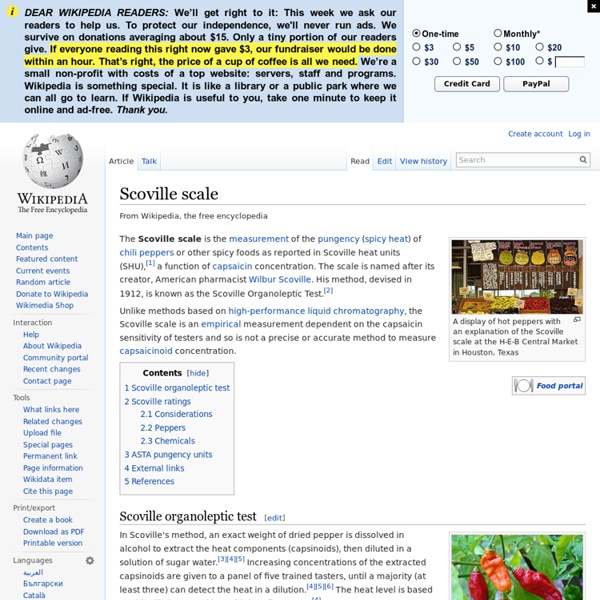Scoville scale
A display of hot peppers with an explanation of the Scoville scale at the H-E-B Central Market in Houston, Texas The Scoville scale is the measurement of the pungency (spicy heat) of chili peppers or other spicy foods as reported in Scoville heat units (SHU),[1] a function of capsaicin concentration. The scale is named after its creator, American pharmacist Wilbur Scoville. Unlike methods based on high-performance liquid chromatography, the Scoville scale is an empirical measurement dependent on the capsaicin sensitivity of testers and so is not a precise or accurate method to measure capsaicinoid concentration. Scoville organoleptic test[edit] Scoville ratings[edit] Considerations[edit] Since Scoville ratings are defined per unit of dry mass, comparison of ratings between products having different water content can be misleading. ASTA pungency units[edit] External links[edit] References[edit]
European Space Agency hacked, sensitive data released publicly - TNW Europe (Build 20110318052756)
It is reported that yesterday the European Space Agency (ESA) website was compromised by a hacker, opening up sensitive project logs and exposing hundreds of email addresses and passwords associated with some of Europe’s top science institutes. The hacker, known by the alias TinKode, posted a full disclosure of the attack on his website, highlighting FTP accounts, database users, hashed passwords as well as SHA1-hashed server root password. Perhaps a little more worrying for the ESA was that fact the attacker was also able to access some of the agency’s space projects including satellite activities, calibration sources and environmental details. Despite showcasing the data stolen in the attack, the hacker did not disclose how the ESA website was compromised. In an edit to the blog post, TinKode notes that an email had been sent to the European Space Agency, notifying them of the breach.
Evolution on the fly: Look, Ma! No genes! - (Build 20100625223402)
U. ROCHESTER (US)—Researchers have identified a new mechanism for evolution that bypasses genes altogether. A research team has chronicled a striking example of a bacteria infecting an animal, giving the animal a reproductive advantage, and being passed from mother to children. This symbiotic relationship between host animal and bacteria gives the host animal a readymade defense against a hazard in its environment and thus has spread through the population by natural selection—the way a favorable gene would. The work by University of Rochester biologist John Jaenike and colleagues provides the first substantial report of this effect in the wild, but he says it may be a common phenomenon that has been happening undetected in many different organisms for ages. Aside from shedding light on an important evolutionary mechanism, his findings could aid in developing methods that use defensive bacteria to stave off diseases in humans.
Related:
Related:



